While the beaches of Redcliffe draw the interstate tourists, the waterways of Hay's Inlet attract the naturalists and environmental community, as well as the providing the basis for much of the fish food on our table.
Hay's Inlet is the 2,400 ha tidal and mangrove area we hurriedly drive past when travelling from Deception Bay to Redcliffe, from Rothwell to North Lakes and from Clontarf to Brighton. Saltwater Creek and Hay's Creek contribute water to the Inlet from Rothwell, North Lake's and Deception Bay. The major water comes to the southern part of the Inlet through Pine River from Brighton, Bald Hills, and as far west as Mr Nebo, Mt Glorious and Ocean View.
These wetlands and the surrounding salt marsh, meadows and lagoons support wader birds, fish, koalas and kangaroos. As well as the wildlife, the area is a principal spawning, breeding area and juvenile habitat for bream, mullet, flathead and whiting. About 70% of the commercial seafood for eastern Australian comes from species which spend some of their life in mangroves.
Hey Hay the May Festival
Like the ancient festivals of England celebrating various aspects within a district of nature's provision of food and shelter for we mere humans, our local clans have begun to also honour the flora, fauna and cosmos of Hay's Inlet.
Join residents and visitors at the 5th biennial Hays Inlet Festival week, scheduled for Friday 30th May till Thursday 5th June 2014.
The organisers this year are:
Bob Crudgington- 0487 770 087
Redcliffe Environment Forum
bobcrudgington@powerup.com.au
Pete Johnson - 0409 953 294
Redcliffe Environment Forum
johnsonpete1@optusnet.com.au
Sally Elliot - (07) 3834 6039
Pine Rivers Koala Care Association
sally.elliot@bigpond.com
Sonya Schmidtchen - (07) 3325 1577
Pine Rivers Catchment Association
catchmentcoordinator@prca.org.au
As the event comes nearer, the festival website will have up-to-date information:
www.haysinlet.com.au
www.facebook.com/HaysInletFestival
www.twitter.com/HaysInletFest
The 2012 event was organised by 30 community groups and 150 individuals. It brought together over one thousand people to celebrate the Hay's Inlet waterway and catchment area. The 2014 event of art, culture and activities should even be bigger; while the 2012 event was based at Pelican Park (Pocket Book map 515 B7), the 2014 event is determining a range of locations around the Inlet itself.
Water Quality
The theme for the 2014 festival is Water Quality. Water Quality is a measure of the three aspects of Salinity, pH and Turbidity. The normal amount of salt in sea water is about 35 parts per thousand, or 35 ppk. Saltmarsh can vary between zero and 100 ppk.
pH is used to look for soil disturbance. (p represents the German Potenz or power, while H represents hydrogen. pH is a logarithmic scale on which 7 is neutral, lower values are more acidic and higher values are more alkaline. The pH = -log10c where c is the hydrogen ion concentration in moles per litre.) Saltmarsh and mangrove can be quite acidic especially when the lower levels beome exposed to air. Stormwater drains can be a source of acidity which disturbs habitat. So pH is measured during higher tide inundation and as the tide recedes.
Turbidity is the measurement of suspended particles within the water. These sorts of particles are often visible to the eye. The basic unit for measuring turbidity is the NTU or Nephelometric Turbidity Units.
See the Inlet Features
To get in the mood, travel around Hay's Inlet looking at the various key habitat viewing points at Bremner Rd Rothwell on Pocket Book Map 497 E7, Chelsea St Kippa-Ring on Map 497 F7, MacDonnell Rd Clontarf on Map 514 H2, Duffield Rd Clontarf on Map 514 G3, and Haysmouth Pde Clontarf on Map 529 H1. Also stop at the viewing and fishing platform on Ted Smout bridge in Bramble Bay on Map 529 G4; you need to cycle or walk from either end of the bridge.
Andrew Powell, Environment Minister, on Hay's Inlet
Andrew Powell, the Queensland LNP Government's Minister for Environment and Heritage Protection, has a fond awareness and knowledge of Hay's Inlet. In his youth, he was school captain of Grace Lutheran College at Rothwell, adjacent to Hay's Inlet. His university science studies included many environmental topics. Upon hearing of this special feature in Pocket Book, Mr Powell personally wrote:
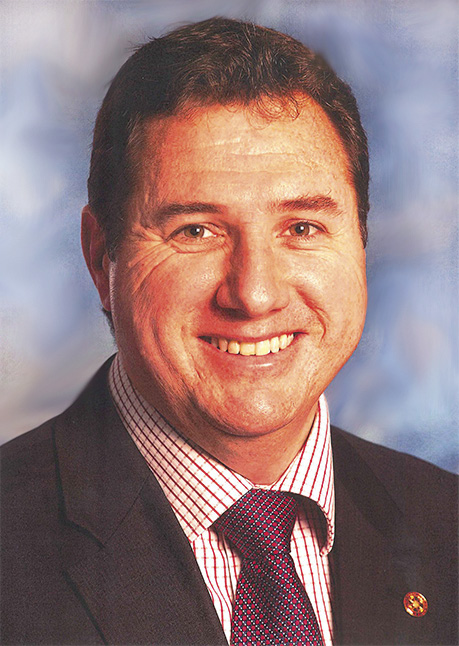
"Queensland's extensive network of waterways and wetlands, including Hay's Inlet, are important for our environment, our economy and our social well-being."
"They have many functions from producing clean water and food for humans, industry and agriculture to providing an important habitat for animals and plants. In order to maintain these values, we need to maintain and enhance our waterways to the best possible condition."
"The Queensland Government is committed to improving the health of these important waterways and their unique ecosystems by undertaking an integrated monitoring and management program, which balances environmental outcomes with ecologically sustainable development."
The fate of a meeting
On Friday 6th December 2013 at about 8:30am I arrived at the Bremner Rd, map 497 E6, entrance to Hay's Inlet environmental park to start a day of taking photos for this front cover story. Just before I could enter the gate a call came from behind: "are you part of the group?" Well, no, not really, but I was certainly interested that a group was about to do some important environmental measurements on the saltmarsh. What a remarkable fate for such co-incidence of a meeting.
Bob from UQ
The person calling out to me was Bob Crudgington B.Sc(Hons) Marine Ecology, and associate lecturer at University of Queensland. He also works with staff of James Cook University on this Hay's Inlet project. Bob is part of an awesome local environmental community organisation (mainly made up of small business operators) known as REF (Redcliffe Environmental Forum) who value the habitats and wildlife around the peninsula and Moreton Bay.
Bob knew his stuff, and 'the group' which did quickly arrive were four marine pilots and two office staff from the firm Brisbane Marine Pilots of Albion and Mooloolaba. They had decided after many years of guiding big ships into the Brisbane harbour, and a little bit smaller ships in Mooloolaba, that they would really like to volunteer some time for, and gain some knowledge about, this eco-system which they might often view from afar from the high up bridge of a ship.
In this special interview for Pocket Books, Bob said:
"As part of the community at Redcliffe and Moreton Bay I feel we should all do our bit to preserve our precious environment, especially wildlife habitat and in particular the coastal ecosystems which keep Moreton Bay clear and full of seafood."
"Saltmarsh is a valuable and productive fish nursery area and also provides extra benefits through filtering our stormwater run off before it enters our creeks and bay. It is a sensitive habitat and anything we can do to stop damage from development and vehicle damage will have a positive impact on Moreton Bay and our coastal lifestyle."
Bob Crudgington can be contacted on 0487 770 087
bob@manicmultimedia.com.au
So I joined their group for the morning as we prepared and then placed stakes, really ordinary one-inch timber garden stakes, to take measurements for the incoming tide. Some of the group also erected fishing nets to catch, tag, weigh and then release fish. I now understand that there is an importance to helping the saltmarsh, especially after seeing those juvenile fish swimming up with the tide. Releasing here at Bremner Rd is very important as this is a closed fish zone helping young fish grow to adults. Fishermen can catch them in a few months in other parts of Moreton Bay when they are about twenty times the size!
Power Lines
One interesting point of discussion was the electricity lines running through the middle of the saltmarsh. This saltmarsh is essential to the young fish, which later become the fish on our table. As $1,400 million is being spent on the new rail line, Bob had requested that perhaps a few tens of thousands of dollars of that expenditure could be used to move the power lines over to the railway corridor. Then the power line repair trucks would not be destroying this important saltmarsh. I assured Bob that next time I chat with Andrew Powell, LNP Minister, I would mention this to him.
I spoke with Andrew Powell about this a few days later, as I have known him since before he entered Parliament. He said he knew those particular power lines quite well, as he had been school captain at Grace Lutheran College, just in the next street. He thought "An early stage yet, but just perhaps putting them into the rail corridor is a good idea."
He made a note to consult his department. Andrew remembered the young fish swimming up the channels. Perhaps he had done a school science project there. I followed up with a short note to his office.
On 17th Dec 2013, Andrew formally replied that:
"I would, in principle, support this proposal being investigated further. As this matter falls within the portfolio responsibilities of the Honourable Mark McArdle MP, Minister for Energy and Water Supply, a copy of your correspondence has been passed to him with a request that a reply be forwarded to you regarding the feasibility of this proposal."
(As this book is going to print just prior to Christmas 2013, the time schedules would not allow a feasibility and reply from Mark McArdle to be included in this article.)
Brisbane Marine Pilots
The group from Marine Pilots had a very interesting perspective on the importance of the environment. Ross Nicholls, the chairman of Brisbane Marine Pilots, was here with his crew doing the research. His words to Pocket Books are an important reflection on how business helps the life of the planet, starting with itself as the individual:
Here is the quote from Ross regarding BMP's involvement:
"We have set targets as a Corporation to ensure we challenge ourselves to minimise the environmental footprint of our business and we have made good progress in achieving these targets. Our accreditation to ISO14001 and EcoBiz is a testament to this and our ongoing progress to achieve and maintain our targets is now a part of our business. In addition to these steps the Company wanted to demonstrate through the actions of our employees that we are serious in our attempts to minimise our footprint and to give back to the environment. Joining forces with AUSMEPA allows us assist, where we can, in some of their Moreton Bay projects."
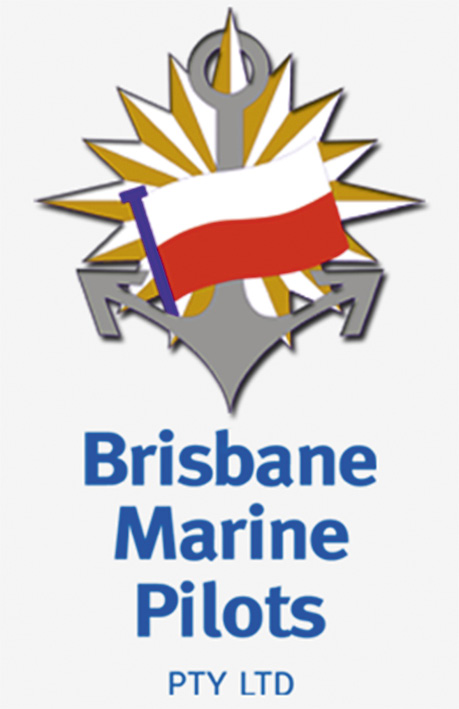
The Brisbane Marine Pilots group comprised Ross Nicholls, Fran Tessier, Chris Gallagher, Julie Gallagher, Peter Lilley and Alex Foresto.
Ph 3624 6513
www.brisbanepilots.com.au
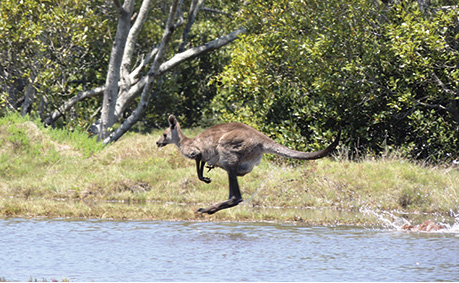

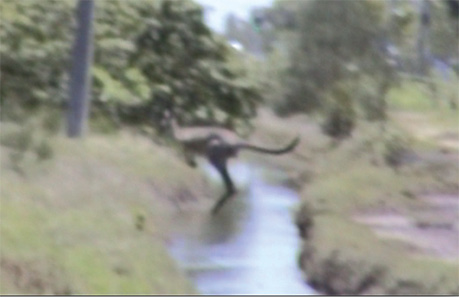
Kangaroo Photos 1, 2 & 3. This mum with joey in pouch certainly shows why Qantas adapts the flying kangaoo as its emblem (Crudgington). The blurred image is one of the two kangaroos which observed our group crossing the channel where we observed the fish (Clarke).
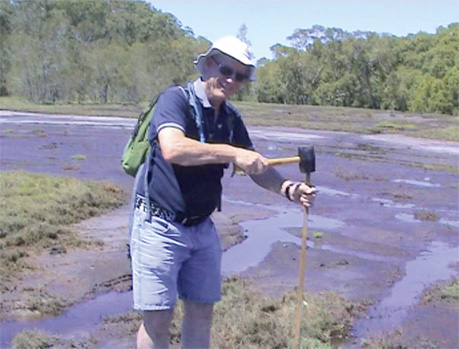
Bremner Rd saltmarsh area at low tide while we were putting up the stakes; yes, that is me with the hammer (above).
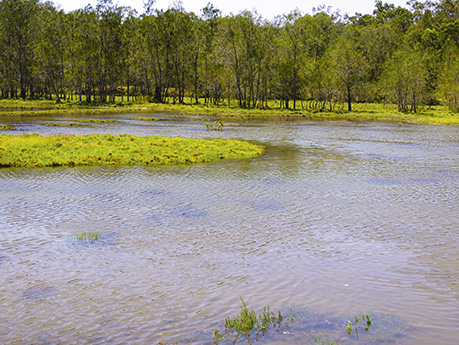
A photo on a different day showing some of the same area at high tide.
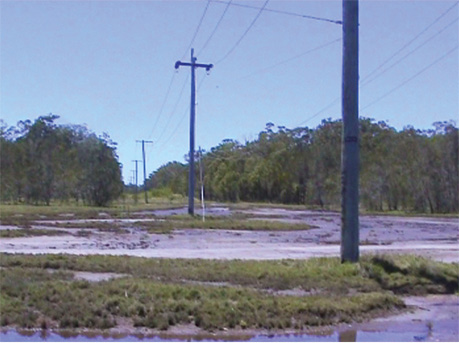
The power lines crossing the salt marsh (Clarke photo).
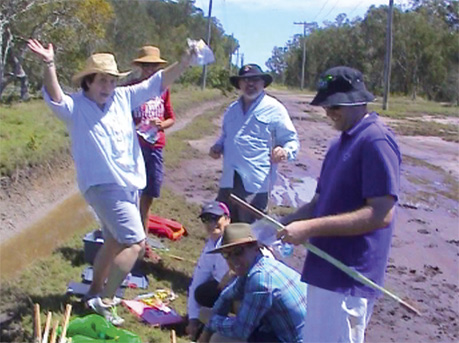
These lads and lasses are usually driving great big ships into our Port of Brisbane. But today they are assistants to Bob (Clarke photo).

This little juvenile fish in the channel behind the lads & lasses photo is what all the day's drama is about. Unfortunately for our article, the toadfish are the first into the channel followed by more sumptuous dinner fishes like bream, mullet, flathead and whiting.
These little chaps will one day grow to a dinner plate size or a tasty morsel for a shark which may later on be in sections on a dinner plate. He was the first swimming up the channel
(Clarke photo above).
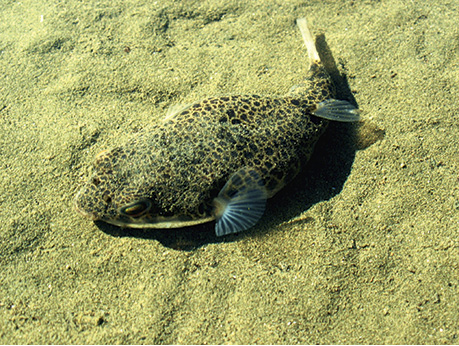
Better detail is from Bob's photo (Crudington Photo above).
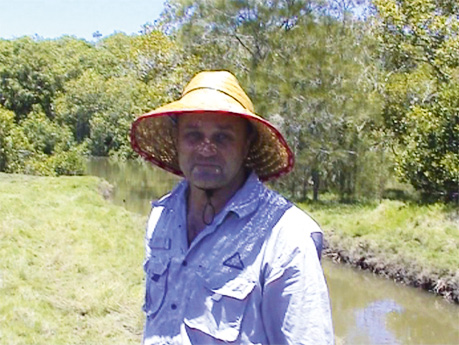
Bob Crudgington
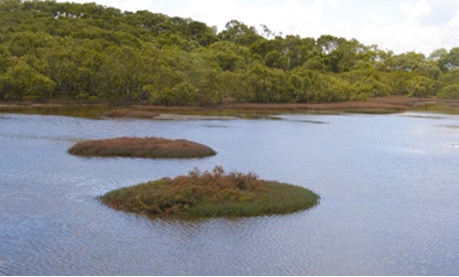
Refuge islands for wildlife as seen on Bob Crudington's Hay's Inlet film (above)
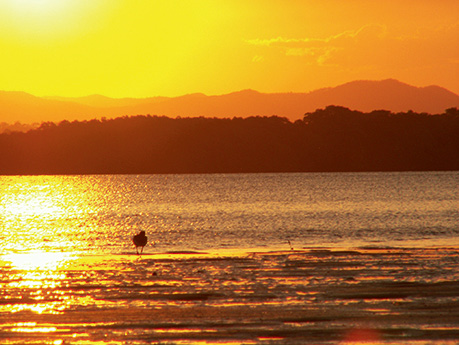
Hay's Inlet at sunset. (Crudgington photo, above).
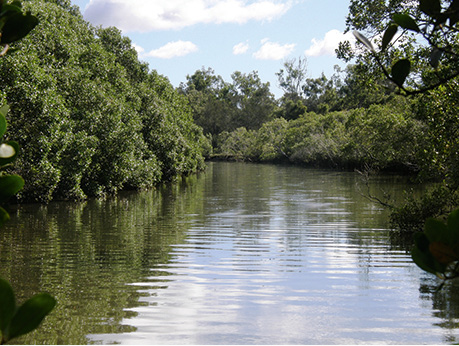
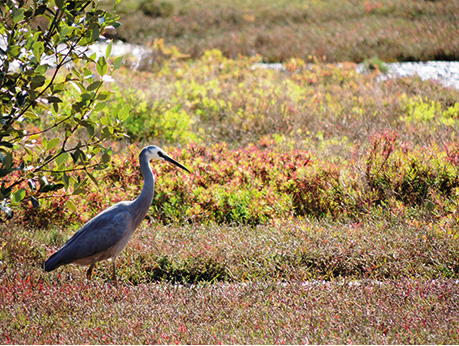
Imagine a canoe trip on these quiet waters (Crudgington photos, above).
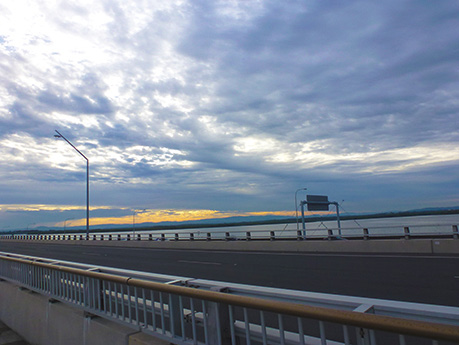
Hay's Inlet viewed from the cycle and foot path on Ted Smout Bridge (Clarke photo, above)
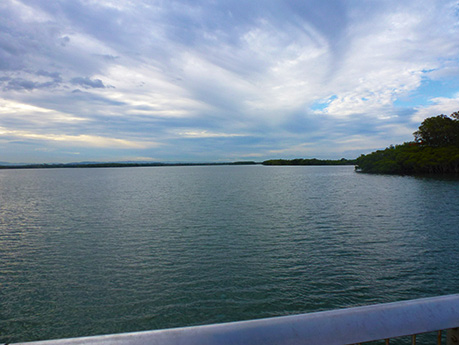
Hay's Inlet in the late afternoon viewed from the platform of Hornibrook Bridge at Clontarf. (Clarke photo, above)
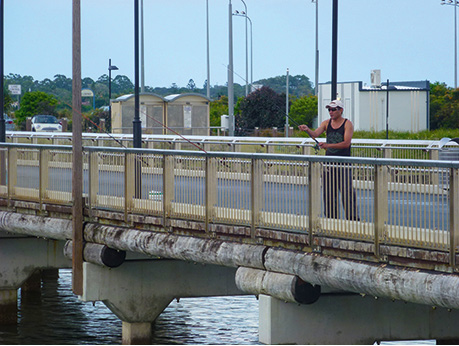
From the fishing platform of Hornibrook Bridge at Clontarf this fisherman is enjoying the later life cycle of the little juvenile from the north end of Hay's Inlet. (note the singing conveniences in the background.) Map 529 H1. (Clarke photo, above)